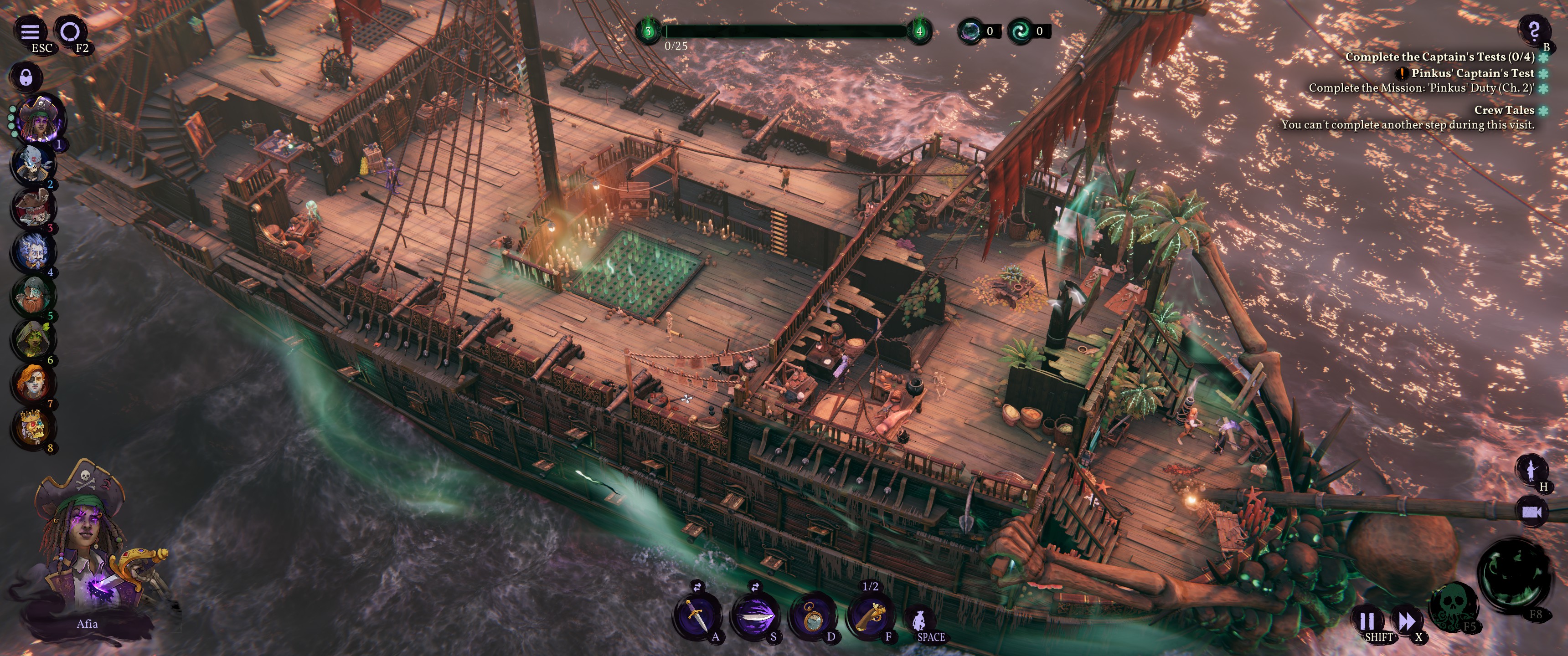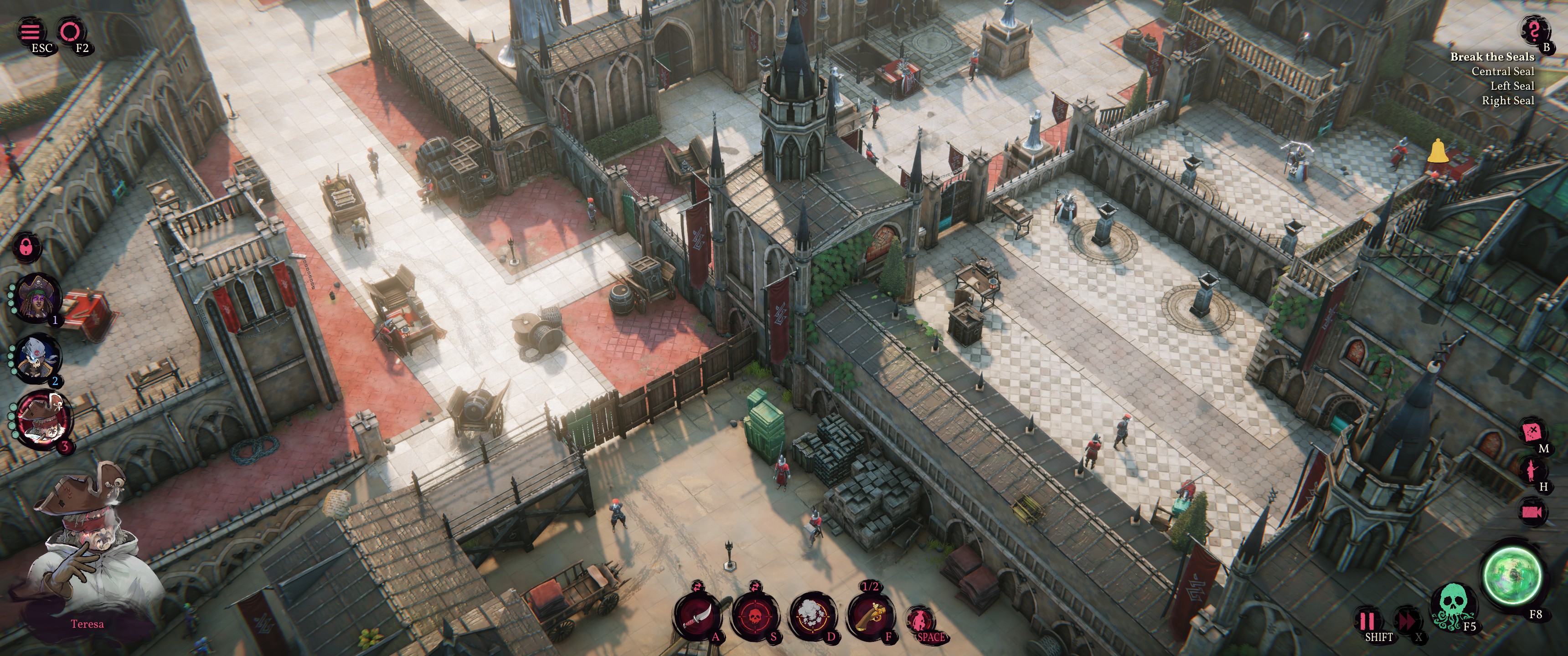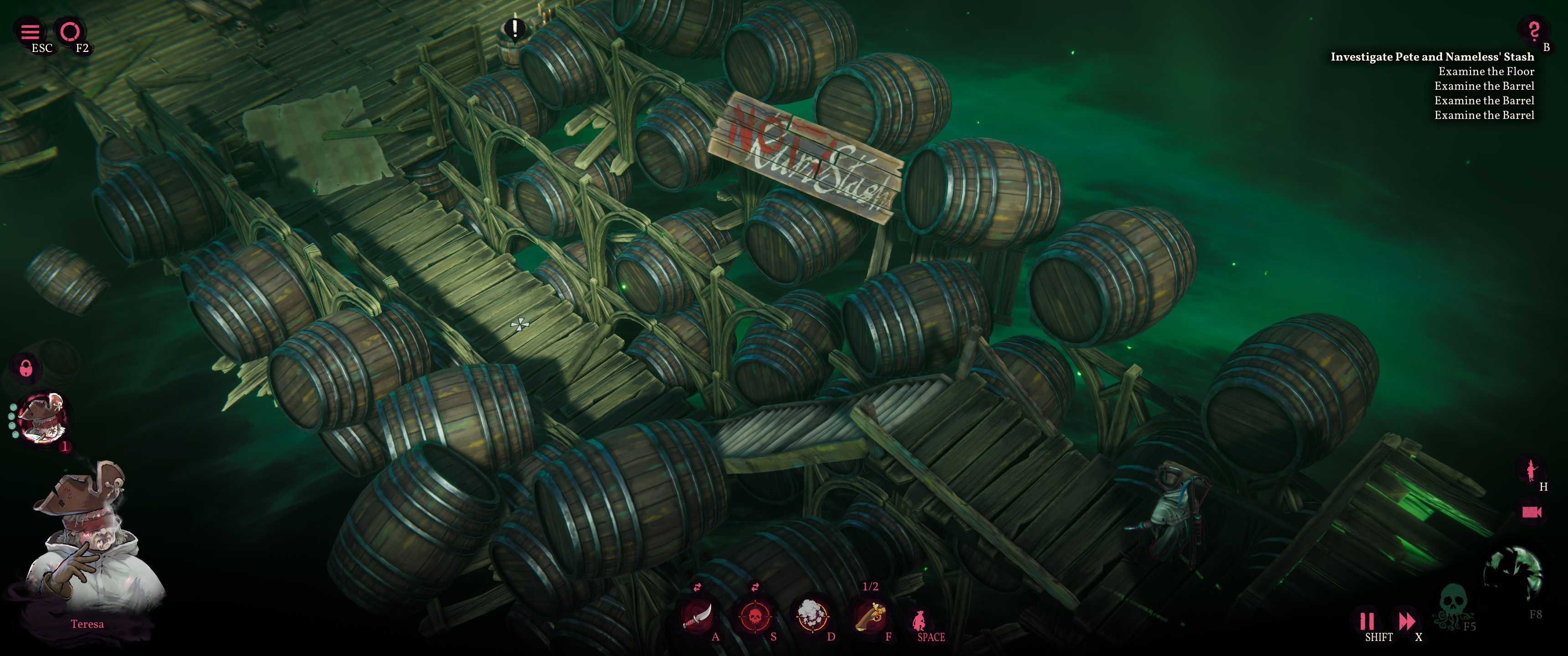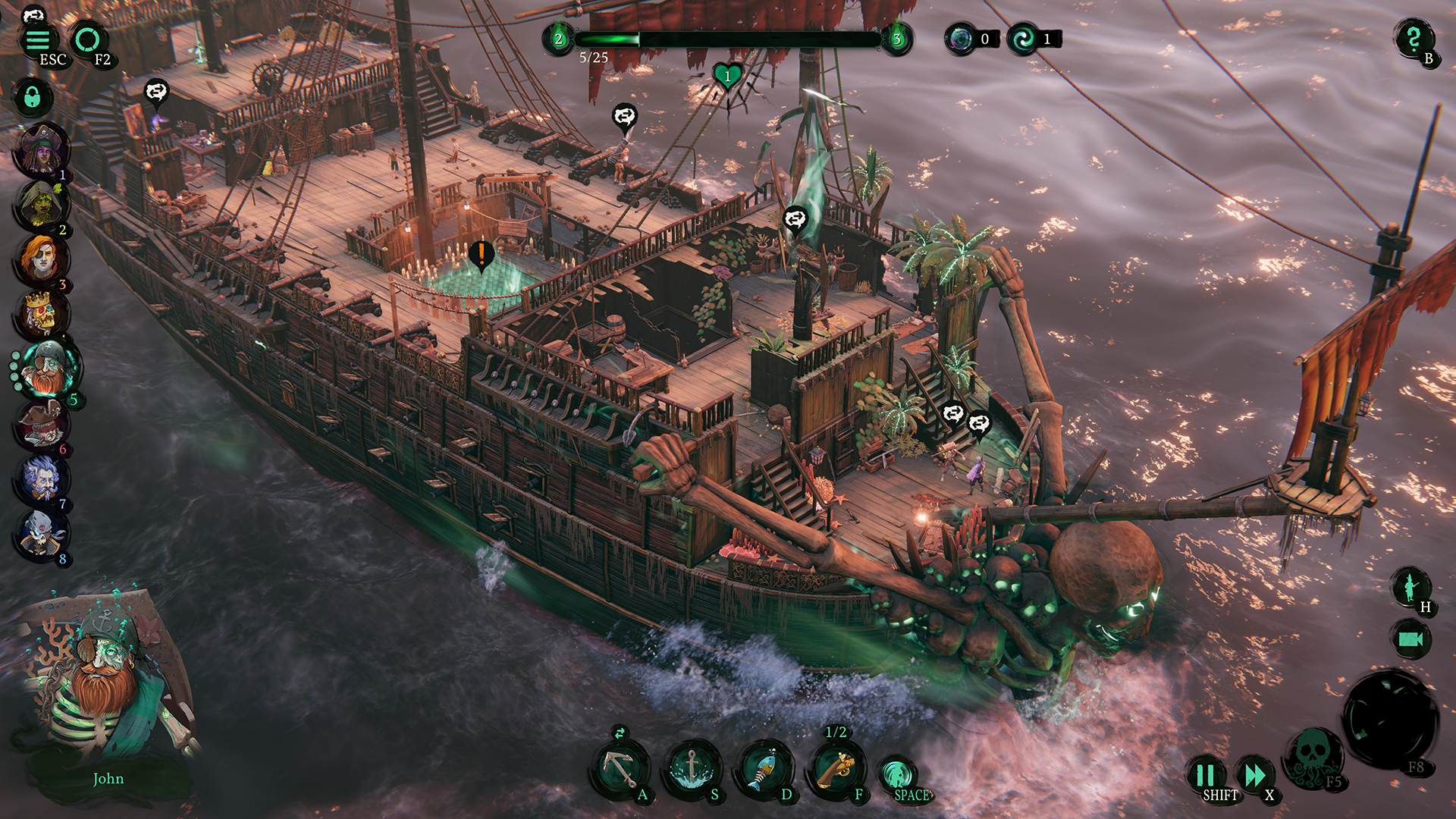Our Verdict
On par with its (excellent) predecessors, Shadow Gambit trades some focused design for deeply compelling piratical freedom.
PC Gamer's got your back
What is it? Stealthy squad tactics with an undead pirate crew
Release date August 17, 2023
Expect to pay $40/£35
Developer Mimimi Games
Publisher Mimimi Games
Reviewed on Windows 11, Nvidia 4090, Intel i9-13900k, 64gb DDR5 RAM
Multiplayer? None
Steam Deck TBA
Link Official site
Mimimi is a studio that understands its niche. Shadow Tactics, Desperados 3 and now Shadow Gambit: The Cursed Crew are fundamentally the same game; tactical squad stealth where players must quick-save and load until they can pull off a flawless heist. This time around, Mimimi is celebrating the power to quicksave. Easily taken for granted, Shadow Gambit makes it a magical plot macguffin and the power of the Red Marley, your sapient pirate galleon.
For newcomers to the series and genre, Shadow Tactics, Desperados 3 and Shadow Gambit are what Mimimi defines as ‘stealth strategy’ games. Take your Metal Gears, Hitmans or Splinter Cells and pull the camera up to an RTS perspective and give the player a small squad of sneaky sorts to complete their goals and get out intact. From this elevated perspective, players are free to plot, plan and see exactly where every guard is looking, which is good, because these maps tend to be absolutely lousy with guards patrols.

Despite the perspective change, it’s immediately intuitive to stealth game fans, dodging sight cones, hiding in long grass, picking off isolated guards and spending limited resources (such as ammo or health) to clear out especially stubborn enemies, as well as using each character’s special abilities to lure out, distract or eliminate foes. Mimimi’s format gives the added opportunity to pause time and synchronize actions for impeccably timed takedowns, refined through as many saves and loads as is needed to pull it off perfectly. It doesn’t matter if it took me twenty failures to pull off a maneuver, because it’s that one golden success that sticks in my memory. It’s an incredibly compelling structure.
Shadow Gambit is no different in its core mechanics, although the magical pirate setting gives it a little more room to get silly than its predecessors. Every mission presents you with an objective protected by a tightly woven pattern of enemy patrols, all seemingly within each other’s sight-lines. One mistake and it all comes tumbling down on your squad, so each mission begins with casing the joint, looking for that one guard that can be isolated, that one thread in the tapestry that can be pulled loose, letting you unravel it all to clear the path.
It’s a tried-and-true formula I’ve enjoyed before and still holds up as well as ever. And if it was just more of the same, I’d be happy enough, but it’s what Shadow Gambit does differently that held my attention for its full and lengthy thirty-odd hour campaign.

Rum doings
As with its predecessors, Shadow Gambit is a mission-based progression through increasingly complex maps, carefully unpicking ever more convoluted webs of guard patrols until your path to the goal is clear. But the framing here is very different. While the other stealth tactics games practically demanded saving and loading, Shadow Gambit treats that option for what it is—borderline godlike power—and the freedom to cheat fate, making it a fine hook to hang a story of piratical ambition from.
Shadow Gambit’s setting is a fun one, sharing vibes with Sea Of Thieves or Pirates Of The Caribbean. Swashbuckling sorcery, with a local populace happy to have the undead wandering around so long as they behave and pay for their rum. The campaign here has you reassembling the undead crew of the Red Marley, a sardonic sapient vessel with the power to save and restore time. Pursued by an order of mystical flame-worshiping inquisitors, the crew are racing against the church militant to find their previous captain’s lost treasure, which of course requires solving a convoluted riddle.

The high-seas fantasy setting affords Shadow Gambit more whimsy in its playable characters and enemy roster. There are eight playable pirates in varying states of undeadness, each with their own supernatural powers. Perspective protagonist Afia has the power to Blink around, Dishonored style, teleporting through view-cones and stabbing at range. The foppish quartermaster Pinkus Von Presswald can possess guards, letting him infiltrate without suspicion, but only within a fixed radius of where he began his possession. Ship’s doctor Suleidy can spontaneously grow shrubberies—surprisingly useful, as a conspicuous bush to hide from snipers goes a long way.

Those powers would probably break a slightly more realistic game, but the enemies here have some magical perks. While most are standard stealth-game guards following familiar patrol routes, there’s some fun twists. Kindred are magically tethered duos who’ll revive each other unless both are taken down simultaneously. Nastiest are Prognosticars, wizards who’ll instantly react to disturbances within their hearing radius with a spell that will freeze the offending undead and kill them a few seconds later. They’re only vulnerable to attack while casting this spell, so have to be tag-teamed. By themselves, not too dangerous, but they’re almost never outside of the protective view-cones of guards, hard-to-distract officers and twitchy crossbow snipers.
Dead and loving it
Every mission in Shadow Gambit forced me into using every member of my three-pirate squad to the fullest, but left squad composition up to me. While the game did warn me a couple of times to bring a character who has the ability to lure away or redirect guards, I found every mission doable with almost any combination of cursed pirates, even if my own decisions forced some creative lateral thinking and unusual applications of their powers. Plus, it’s just fun to play around with the crew—they’re a fun bunch of ghosts, half-zombies, plant-people and skellingtons.
They’re a funny and likable bunch, well voiced, with accents from across the seven seas. They’ve plenty to say on each mission, personal side-stories on board the Marley between raids, and plenty of banter to hear in-mission, reacting to each other’s powers and your own quicksaving and loading. Being undead, they also share a rather laissez-faire attitude to mortality. While you have the option to expend more time and effort to knock enemies out instead of killing them, there’s little mechanical reason to, and thematically they’ll be up and haunting the place in no time anyway. While I’m sure pacifist playthroughs are possible, I’m saving that for another playthrough.

The tradeoff for this increased freedom is that Shadow Gambit sometimes feels less authored than its peers. Earlier Mimimi games felt like you were given a series of long, complex bespoke puzzles to solve with a fixed set of tools. While there was always some flexibility, you were still solving puzzles as intended. Instead, Shadow Gambit is set across an archipelago of islands, each holding several missions to pick from, and each sortie letting you pick your point of entry, exit and what tools you’ll be using for the job.
Shadow Gambit’s story breaks down nicely into three acts, each of which ends in a larger mission. Each gives the player more freedom than the last in how to progress, both in terms of what missions they choose to undertake (and in which order), and in how those missions are approached. Outside of some missions that demand a specific pirate, you’re free to pick, with only the occasional nudge to choose frequency benched characters to earn more experience points for unlocking secondary powers, with one upgrade available per character.

Uncharted waters
This added freedom isn’t really a positive or negative change for the series, just a lateral shift that gives Shadow Gambit its identity, which feels eerily similar to both Dishonored and the Hitman: World Of Assassionation trilogy. The puzzle-boxes may be fixed problems to solve, but the tools you bring can be wildly different each time. With eight characters to pick from, each with their own mobility options and supernatural powers, I found myself changing up my squad at every opportunity just to see what fun new approaches and synergies I could discover, and I fully expect almost every player’s experience to be different.
After losing no small amount of sleep to ‘just one mission more’ compulsion, I’ve very few solid criticisms to level at Shadow Gambit, outside of yawning and itchy eyes. If I had to nitpick, I’d say that the first act of the story takes longer to ramp up than I’d like, but that’s only as a stealth strategy veteran. The learning curve and smaller scope of earlier missions should help newcomers on board. A slightly more direct issue is that some of the crew’s powers can be fiddly to use in real-time, like Gaëlle le Bris and her people-launching cannon. Trying to launch a specific person when two are laying on the ground beside each other felt like a coin-flip at times, and targeting when multiple enemies were near a ladder was similarly fiddly, leading to a few instances of two characters attacking the same guard.

Despite Shadow Gambit’s missions being smaller on average than in Desperados (most around 20-30 minutes, with the occasional hour-long setpiece), this is a bountiful barrel of grog, clocking in at around thirty hours long, and unlocking a pirate’s hoard of post-game challenges to encourage replaying previous missions. With flexible difficulty settings (letting you tweak enemy placement, AI response times and even how many times you’re allowed to save per mission) and multiple approaches to every mission, there’s plenty of reason to replay earlier islands here. While I never really felt compelled to return to Mimimi’s earlier games, I can see myself reinstalling this as a regular event.
Whether it’s experimenting with powers, working out the perfect play or just speedrunning, I can see each player finding their own reason to return long after the story’s conclusion. This one’s a real treasure, even if you might have to dig a bit to get to the really shiny plunder.
On par with its (excellent) predecessors, Shadow Gambit trades some focused design for deeply compelling piratical freedom.

The product of a wasted youth, wasted prime and getting into wasted middle age, Dominic Tarason is a freelance writer, occasional indie PR guy and professional techno-hermit seen in many strange corners of the internet and seldom in reality. Based deep in the Welsh hinterlands where no food delivery dares to go, videogames provide a gritty, realistic escape from the idyllic views and fresh country air. If you're looking for something new and potentially very weird to play, feel free to poke him on Bluesky. He's almost sociable, most of the time.


